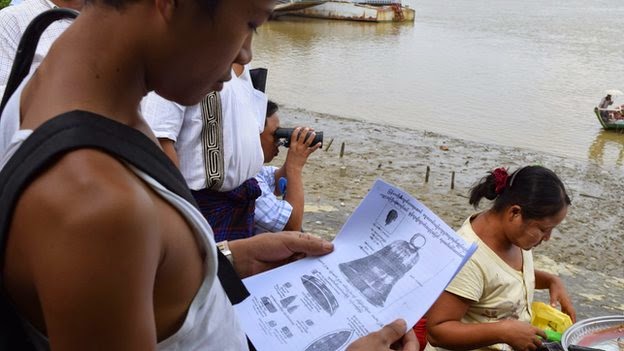 |
| Galoun - Mythical half man half bird |
Alas, de Brito had not read the Wikipedia article about how to calculate fully loaded displacement of a boat, and when he attempted to ferry the 270 ton bell across the swift moving Yangon River, it promptly sank. To put this into perspective, 270 tons is roughly the equivalent to the maximum gross takeoff weight of a Boeing 777 (or about 6,136 fully grown Emperor Penguins for those of you on the metric system).
 |
| Mugshot of the Dhammazedi Bell |
 |
| Shwedagon Pagoda as it appears today - sans bell |
Why hasn't the bell been recovered in all this time? Witnesses to the sinking knew precisely where the bell had gone down, and the river is only around 30 feet deep at low tide. Has the bell somehow joined Amelia Earhart and MH370?
No fewer than seven attempts to locate and recover the bell have been made in the last three decades alone however none has been successful, due in part to the fast moving tidal river currents and murky waters, leading some to declare that the effort is cursed. “Several divers had already died looking for the great bell, including two Myanmar Navy divers who became trapped inside a wreck and died horribly” American diver Jim Blunt told The Independent. According to local newspaper, The Irrawaddy, historian U Chit San Win has made it his mission in life to relocate this lost artifact of Myanmar’s past. Since 1987, he has led a number of searches, including one in 1996 that was supported by then Military Intelligence chief Gen. Khin Nyunt. During one attempt in the 90's, U Chit San Win lost a son to rabies. When asked what he thought about the bell's curse, he declined to give a direct answer.
Others have been less reticent about expressing their concerns. During a meeting between U Chit San Win and a government minister that was observed by a member of The Irrawaddy’s staff, the minister attentively listened to a detailed proposal to launch another search, but in the end declined to back the project because, he said, he feared for the safety of his family. Yet, there are many who superstitiously maintain that recovery of the bell could be the key to the country’s return from its current status as one of Asia’s poorest nations. According to U Chit San Win, “Our country is so poor and plagued with conflict. Many people believe that if the bell is found, it will bring us peace and prosperity.”
At some point, the former military junta that ran the country declared that only citizens of Myanmar have the right to search for the bell because recovering it is a “national issue”. This view is still held by many in the current government and has caused rejection of recent offers of assistance from outsiders. Meanwhile, dissident groups have decried all recovery efforts, claiming that doing so would only serve to legitimize the illegal regime.
Rejecting technology, a new team of locals has received permission, and begun to search for the bell. The latest salvage team consists of about 70 people, including 10 divers recruited from Myanmar’s Myeik Archipelago. These divers are heralded for their ability to dive for long periods without breathing apparatus. Instead of Ground Penetrating Radar, Seismic Surveys, geophysics, or other hi-tech goodies, their search is guided by a monk sitting atop one of the salvage boats.
 |
| Vendors sell snacks and information pamphlets to spectators who gather on the riverbank to watch the search efforts |
 |
| Divers work without scuba gear in near zero visibility to search the muddy riverbed (photo BBC News) |
But, before you book tickets to hear the bell rung at New Years, some are skeptical of the team's discovery. It seems that to date, the divers have provided no actual evidence of their claim. There were a handful of large, A-Class ship mooring buoys that were sunk in the vicinity during World War II. These buoys were of approximately the same size as the bell, have a similar ring at the top, and could easily be mistaken for the bell.
There are even some who doubt the existence of the bell altogether. Curiously, it seems that for the first 200 or so years after the alleged[?] theft, no mention of the bell at all was made in any Burmese literature. Could this whole story just be an urban myth? Have they just been pulling our (bell) chain all these years? We may know in a matter of weeks.
===============
Okay, okay, I've taken a few weeks off since the last blogpost. At first it was just too darned hot to spend much time outside wandering the streets. Now its monsoon season and things have cooled off nicely so I don't really have an excuse.
- Eric